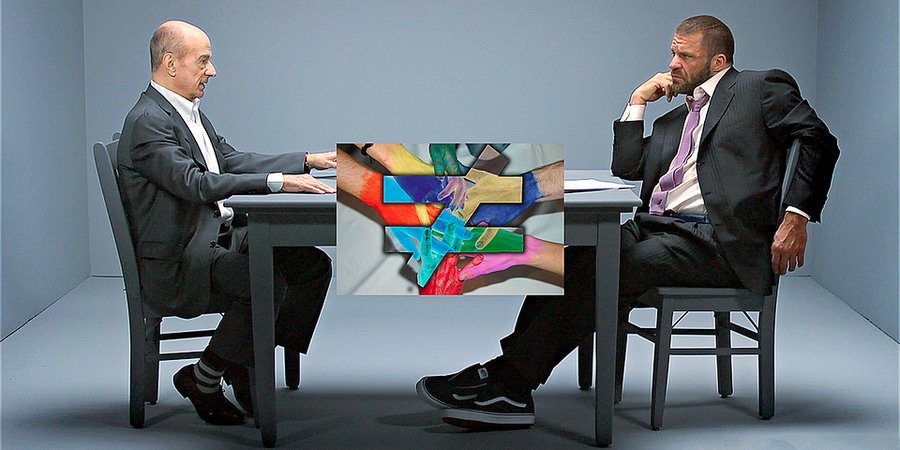It's one of the beautiful things about art: when you look at a piece of work, any interpretation is valid, any reading acceptable. Meaning is created in a pas de deux between the artist and the viewer. Talking about art, however, can be a different and much dicier thing. Depending on the context and who you're talking to (a German art dealer, say, or a Margiela-clad academic), certain words become freighted with unexpected meanings, accrued because someone somewhere wrote an important, discourse-changing essay that you never even heard about. Sometimes, the most basic terms are the most fraught.
To help negotiate with this strange lexical terrain, here is the first part in a new series, in which we will unpack loaded words of their tangled meanings (sometimes further confusing things in the process).
"MODERN" (ˈmä-dərn)
So commonplace in the art discourse, "modern" is actually one of the squirreliest and most problematic words in the lexicon. Traditionally applied to European and American work made between the late 19th and early-to-mid-20th centuries, Modern art with a capital "M" was created by artists like van Gogh, Picasso, Malevich, Duchamp, and other famous figures in direct reaction to the tumultuous impact of the industrial revolution, the ideas of revolutionary thinkers (Marx, Hegel, Freud), and newly mechanized warfare.
However… this notion of modernity is starkly Western-centric. For one thing, in their search for access to "primitive" pre-industrial touchstones, the Moderns cast a colonial view on artworks from Africa, Polynesia, Japan, and other distant places, copying elements of their aesthetic into their work. This did not go unnoticed by non-Western artists at the time—in fact, a group of artists in Brazil in the 1920s declared that they would reverse this power dynamic and copy elements of European art to make their own Brazilian amalgam (they called themselves the Anthropophagics, or cannibals).
Nowadays, a more globalized worldview and a half century of progressivism in the academies has led to an increasingly embrasive view of modernism, with the Museum of Modern Art devoting enormous resources to recuperating non-Western art histories into its canon. But one should note that while these other cultures are being recognized for their modern art, the convention still restricts capital "M" Modernism to the West.
"CONTEMPORARY" (kən-ˈtem-pə-ˌrer-ē)
Compared to "modern," which at least can be vaguely situated as a historical period of industrial modernization, the term "contemporary" has a simple problem: it doesn't make sense. Essentially meaning that the artwork was made at the same time as the term is being applied, contemporary has somehow escaped its necessarily narrow literal meaning to encapsulate an ongoing era of contemporaneity.
Just look at the categories that the auction houses use to describe their sales of art made after the 1950s (or thereabouts): Christie's calls theirs "postwar and contemporary," suggesting that there is a point where the postwar era ends and a contemporary epoch begins, while Sotheby's simply calls theirs "contemporary," demarcating the past 70 years as a period of continuous now. This temporal slippage poses a quandary for future art historians—either they will have to demarcate our current era as a finite "Contemporary" period or create a new term altogether.
"PRACTICE" (ˈpraktəs)
Perhaps you've heard an artist talk about their "practice" before, spied the word used in an issue of Artforum (or, heaven forfend, October), or caught it tossed around in a professorial art talk. So, what exactly are they talking about? One of the more polarizing words in the argot of professional art, "practice" is intended to encompass every aspect of an artist's creative output, from their concepting to their process to their positional essays to, finally, the works of art themselves. It also, sneakily, equates the artist with a highly trained specialist, such as a dentist or psychiatrist, who runs a small business in an clinical environment that is intended to help patients or clients in a specific way.
This implicit comparison embedded in the term has rubbed many art lovers the wrong way, including New York Times critic Roberta Smith, who in a much-read 2007 article bemoaned that its usage "converts art into a hygienic desk job and signals a basic discomfort with the physical mess as well as the unknowable, irrational side of art making." As such, "practice"—or, worse, its infinitely more pretentious Greek cognate "praxis"— has become something of a shibboleth, marking its user as an enthusiast of an academically driven way of viewing and talking about art. Another way to say the same thing, incidentally, is to talk about an artist's "approach."



























